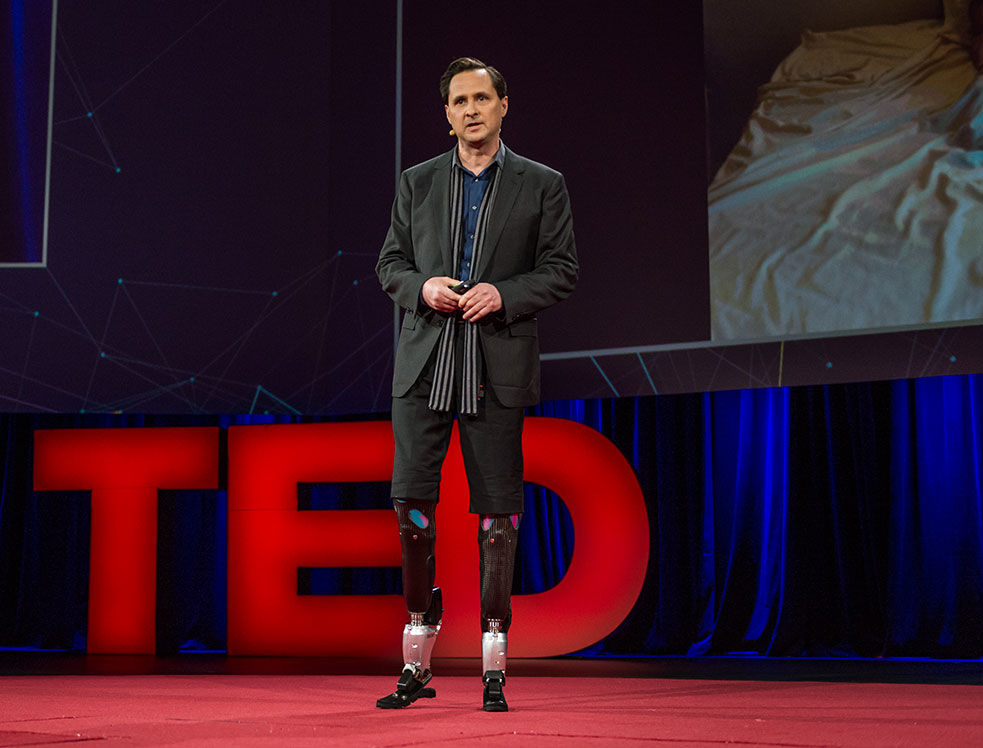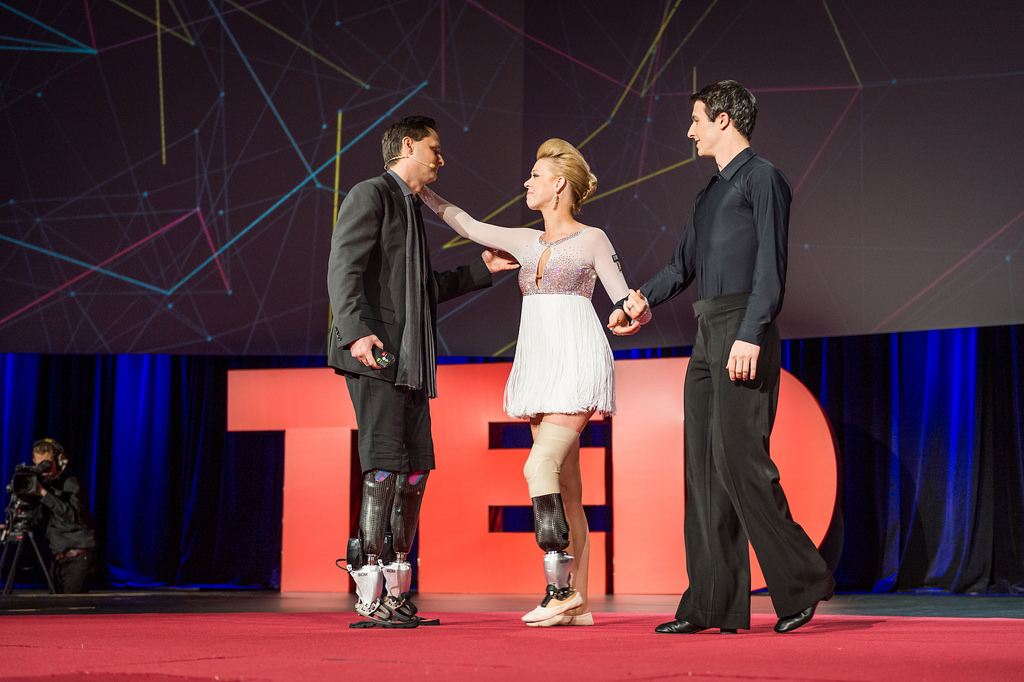
Hugh Herr’s talk transfixed the audience at TED2014, and has now been viewed nearly 2 million times. So it might surprise some to know that his talk took nearly 7 years to happen. Photo: James Duncan Davidson
“As you can see, my legs are bionic,” said Hugh Herr on the TED2014 stage. “The artificial part of my body is malleable, able to take on any form, any function, a blank slate through which to create structures that can extend beyond biological capability.”
Standing tall in a suit hemmed at his knees, Herr spoke eloquently about his work creating the next generation of bionic limbs. He demonstrated how his own worked as he spoke, moving gracefully around the red carpet. This talk—which ended with ballroom dancer Adrianne Haslet-Davis performing for the first time since she lost her left leg in the Boston Marathon bombing—was one of the most-beloved of TED2014. But it took seven years for Herr to step onto the TED stage.
TED Content Director Kelly Stoetzel first spotted Herr seven years ago at the MIT Media Lab, during the h2.0 Symposium. (Executive Producer of TED Media June Cohen also saw him speak around that time.) During the conference, Herr—a renowned rock climber, the director of the lab’s Biomechatronics Research Group and the founder of BiOM Inc.—gave a talk on new horizons in orthotics and prosthetics, showing how new technologies are merging bodies and machines. Stoetzel was moved by the way in which Herr thought: he viewed something that most would consider a hindrance as a source of possibility.
“At h2.0, Hugh Herr didn’t reveal that he was a double amputee until the end of the talk, when he rolled up his pants,” Stoetzel said. “He then blew us all away by climbing up a rock wall on the stage and bouldering across it.”
At that symposium, Stoetzel also scouted Deb Roy, Aimee Mullins and John Hockenberry, all of whom have spoken on the TED stage at some point since. But Herr remained on the TED curation team’s short list for years. When the theme for TED2014 emerged as “The Next Chapter,” focusing on the most significant developments of the last 30 years, they were excited to reach out to Herr about speaking. His work felt like it matched that criteria perfectly.
At BiOM Inc., Herr and his team create “personal bionics” for individuals — products that emulate and even augment physiological function. For example, the Rheo Knee has a microprocessor that senses the joint’s position, as well as the loads being applied to it, and adjusts accordingly. And when he created bionic limbs to best suit his own body, Herr thought of ways to make himself a stronger, more agile rock climber. He developed narrow, wedged feet that can fit in rock fissures and a spiked version to allow him to climb vertical ice walls. In different contexts, he can attach and detach them, just as someone might change bicycle tires when faced with new terrain.
“The first time we spoke on the phone in preparation for this year’s conference, Herr told me that he envisions a future where, after someone loses a limb, they can go to the hospital and get a menu of replacement options, some of which can provide superpowers,” Stoetzel said. “That was inspiring.”

After dancing for the first time in public since losing her left leg in the Boston Marathon Bombing, Adrianne Haslet-Davis thanks Hugh Herr. Photo: James Duncan Davidson
Herr and his team have worked on personal bionics for a wide variety of individuals in need of replacement limbs. “A few months before TED2014, Herr mentioned that he was working with Adrianne Haslet-Davis, a ballroom dancer who lost her left leg in the Boston terrorist attack,” Stoetzel said.
Herr and Haslet-Davis first met at the Spaulding Rehabilitation Hospital, where she went to recover after the attack. After hearing her story, Herr felt compelled to build her a bionic limb to help her get back on the dance floor. He brought together MIT scientists with expertise in prosthetics, robotics, machine learning and biomechanics and, over a period of 200 days, they studied how dancers move. They took the “fundamental principles of dance,” as Herr puts it in his talk, and “embedded that intelligence into the bionic limb.”
Less than a year after the Boston terrorist attack, the work was complete. With just a few weeks before the TED conference, Herr told this to the curation team, and suggested that he invite Haslet-Davis to join him onstage to publicly demonstrate the fluid use of her new bionic limb. The curation team loved the idea.
Haslet-Davis traveled with Herr to TED2014 to appear at the end of his talk. He presented her to the audience with warmth in his voice: “Ladies and gentlemen, please allow me to introduce Adrianne Haslet-Davis, in her first performance since the attack.”
The TED2014 audience erupted with emotion and applause as Haslet-Davis and her dance partner, Christian Lightner, performed a beautiful duet, full of rapid dips and swings, her right leg and bionic left leg moving flawlessly in sync.
In the end, Stoetzel and the rest of the TED team were thrilled with Herr’s talk.
“Even without Adrianne Haslet-Davis’ appearance, the talk would have been great,” Stoetzel says. “But it was so delightful that he was able to show the insanely quick progress of developing her bionic limb. Having her participate in his talk was icing on the cake.”
[ted id=1959]
Comments (14)